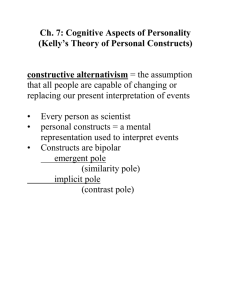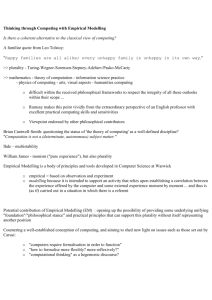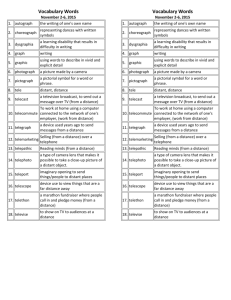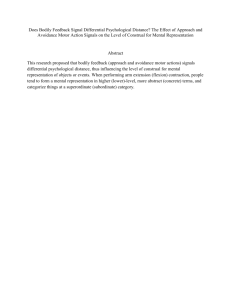CLT notes1 - Personal.psu.edu
advertisement
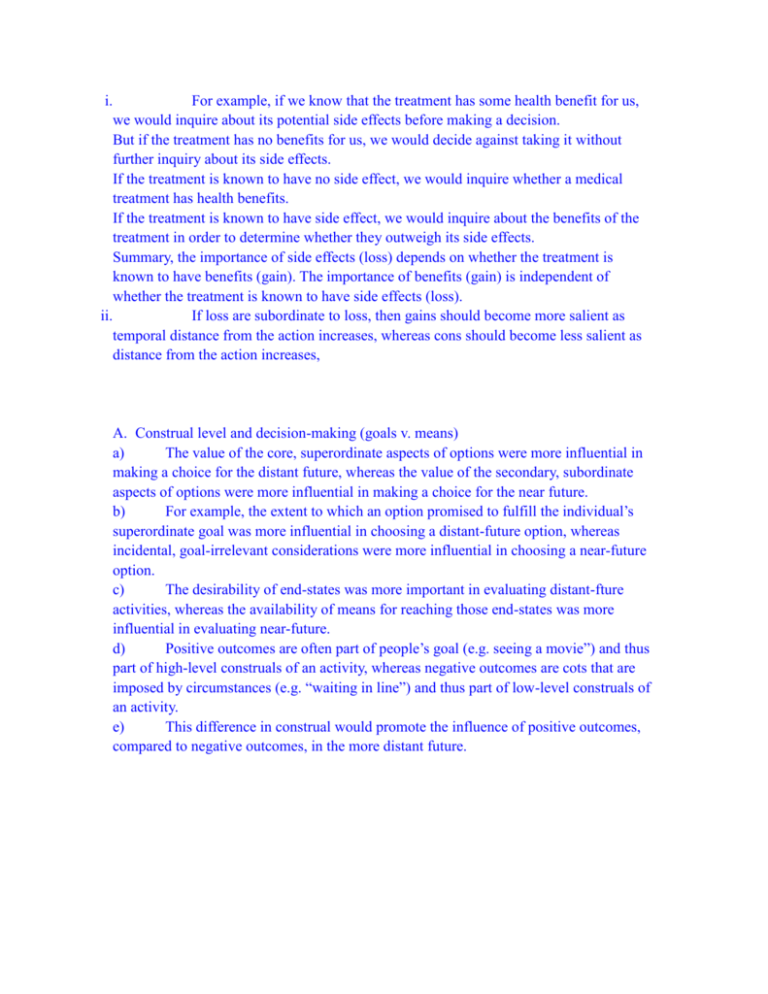
i. For example, if we know that the treatment has some health benefit for us, we would inquire about its potential side effects before making a decision. But if the treatment has no benefits for us, we would decide against taking it without further inquiry about its side effects. If the treatment is known to have no side effect, we would inquire whether a medical treatment has health benefits. If the treatment is known to have side effect, we would inquire about the benefits of the treatment in order to determine whether they outweigh its side effects. Summary, the importance of side effects (loss) depends on whether the treatment is known to have benefits (gain). The importance of benefits (gain) is independent of whether the treatment is known to have side effects (loss). ii. If loss are subordinate to loss, then gains should become more salient as temporal distance from the action increases, whereas cons should become less salient as distance from the action increases, A. Construal level and decision-making (goals v. means) a) The value of the core, superordinate aspects of options were more influential in making a choice for the distant future, whereas the value of the secondary, subordinate aspects of options were more influential in making a choice for the near future. b) For example, the extent to which an option promised to fulfill the individual’s superordinate goal was more influential in choosing a distant-future option, whereas incidental, goal-irrelevant considerations were more influential in choosing a near-future option. c) The desirability of end-states was more important in evaluating distant-fture activities, whereas the availability of means for reaching those end-states was more influential in evaluating near-future. d) Positive outcomes are often part of people’s goal (e.g. seeing a movie”) and thus part of high-level construals of an activity, whereas negative outcomes are cots that are imposed by circumstances (e.g. “waiting in line”) and thus part of low-level construals of an activity. e) This difference in construal would promote the influence of positive outcomes, compared to negative outcomes, in the more distant future. iii. Social interdependence (low-level construal) and close social ties give rise to attention to relationship between objects, whereas social independence (high-level construal) gives rise to isolating objects, attending to their attributes, and assigning them to abstract categories. They included three health issues in their study -- cell phone radiation, mononucleosis, and heath disease. The A robust finding that has been replicated in various contexts is that people selectively recruit information that favors the self, presumably to maintain self-esteem. Perceived social distance (between oneself and another person) leads to positivity effects such that one perceives oneself as less prone to negative events such as becoming ill, having an accident, and contracting AIDS, or hepatitis C as comparged to others. The social distance manifests in the self-positivity bias occurs inrespective of age, occupational status, gender, or level of education. In a similar vein, studies on the third-person effect in communication have not only demonstrate that individuals exposed to a negative persuasive message perceive that it has a greater effect on others than on themselves. The expect that social distance increases psychological distance from the threat, thereby inhibting self-risk perceptions. f) LT predicts: then, that when the value associated with low-level construals is more positive than that associated with high-level construals, time delay would discount the attractiveness of an option. In contrast, when the value associated with low-level construals in less positive than that associated with high-level construals, time delay will augment the attractiveness of an option. Near-future Distant-future Self Other as distant increases… If low-level construal is positive, Option becomes less attractive If low-level construal is negative Option becomes more attractive B. Construal level and decision-making (goals v. means) a) The value of the core, superordinate aspects of options were more influential in making a choice for the distant future, whereas the value of the secondary, subordinate aspects of options were more influential in making a choice for the near future. b) For example, the extent to which an option promised to fulfill the individual’s superordinate goal was more influential in choosing a distant-future option, whereas incidental, goal-irrelevant considerations were more influential in choosing a near-future option. c) The desirability of end-states was more important in evaluating distant-fture activities, whereas the availability of means for reaching those end-states was more influential in evaluating near-future. d) Positive outcomes are often part of people’s goal (e.g. seeing a movie”) and thus part of high-level construals of an activity, whereas negative outcomes are cots that are imposed by circumstances (e.g. “waiting in line”) and thus part of low-level construals of an activity. e) This difference in construal would promote the influence of positive outcomes, compared to negative outcomes, in the more distant future. C. Construal level, general values and self-identity a) In CLT, one’s general values (abstract knowledge) are more likely to be invoked as guides for one’s distant-future behavior than one’s near-future behavior. b) For example, the decision to donate blood in the distant future is likely to reflect one’s attitude toward blood donation, whereas the decision to donate blood in the near future is more likely to reflect specific situational factors, such as when and where the blood donation will take place. c) As a result, general preexisting attitudes are likely to be better predictors of distant-future than near-future behavioral intentions. d) People may see their values as central to their self-identity and pragmatic, situational considerations as less central. e) If so, CLT predicts that people would feel that their self-identify would be expressed in the distant future but not in the near future. D. Construal level and people’s prediction about future a) The greater the temporal distance from a future situation, the more likely are the predictors to be based on the implications of high-level rather than low-level construals of the situation. b) Predictions about the more distant future should be made with less confidence because it is harder to make accurate predictions about the distant future than the near future. c) Because abstract, high-level construals are less complex than concrete, low-level construals, people may feel no less and even more confident in predicting the distant future than the near future. d) More relevant to this research, Ebert (2005) investigates the influence of social distance on the way people make judgments. In one of her studies, participants were asked to list the long-term benefits (i.e., high-level construals) and short-term costs (i.e., low-level construals) of a particular course of action. Then half of the participants rated the importance of the long-term benefits and short-term costs for themselves, whereas the other half did the rating for their friends. Interestingly, Ebert found that short-term costs were rated as being much more important when the judgments were made for selves versus friends. Long-term benefits, on the other hand, were perceived as equally important under the two conditions. Consistent with CLT, Ebert’s research suggests that low-level construals such as short-term costs of a course of action tend to be more influential in forming judgments for a socially proximal entity (e.g., self) than for a socially distant entity (e.g., a friend). iv. Stephan (2005) An increase of social distance more politeness less familiarity b) Increasing psychological distance from a future situation would make it more likely that predictions about this situation would be based on the implications of high-level rather than low-level construals. c) As distance increase enhance confidence in predicting the distant objects (such as future, or others, things happen in Africa This is because that overconfident predictions stem from relying on oversimplified representations of situations. d) Arguments in favor of and against an action i. In favor of an action= pros, gains ii. Against an action = cons, loss iii. In deciding whether to undertake an action, cons (low-level construal) are subordinate to pros (high-level construal) iv. For example, if we know that the treatment has some health benefit for us, we would inquire about its potential side effects before making a decision. But if the treatment has no benefits for us, we would decide against taking it without further inquiry about its side effects. If the treatment is known to have no side effect, we would inquire whether a medical treatment has health benefits. If the treatment is known to have side effect, we would inquire about the benefits of the treatment in order to determine whether they outweigh its side effects. Summary, the importance of side effects (loss) depends on whether the treatment is known to have benefits (gain). The importance of benefits (gain) is independent of whether the treatment is known to have side effects (loss). v. If loss are subordinate to loss, then gains should become more salient as temporal distance from the action increases, whereas cons should become less salient as distance from the action increases, II. Social Distance Research related CLT has been mostly concentrate on the dimension of temporal distance, which the representation of the time frames would play a role in guiding preferences or evaluation about a same issue. Relatively, social distance hasn’t been a central a) CLT has been central in the investigation of the effects of temporal distance on perceptions and judgments. However, it has been utilized rarely to gain a better understanding of the perceptual and judgmental influences of social distance, another common form of psychological distance. b) Consistent with these assumptions, previous research has shown that people tend to explain others’ behaviors in dispositional (i.e., high-level, abstract) terms and their own behavior in situational (i.e., low-level, concrete) terms (e.g., Fiedler, Semin, Finkenauer, & Berkel, 1995). c) Other research has demonstrated that people tend to perceive in-groups and out-groups differently. Compared with in-groups, outgroups are perceived as more homogenous (e.g., Jones, Wood, & Quattrone, 1981), as having more predictable sets of properties (e.g., Linville, Fischer, & Yoon, 1996), and are described in more abstract terms (e.g., Fiedler et al., 1995). B. Social distance and message framing a) According to CLT, differences in mental representations of events associated with large versus small psychological distance can have significant evaluative consequences. More specifically because high-level construals become more salient as psychological distance increases, we should expect judgments about the event be more determined by high-level construals when psychological distance is large versus small. In contrast, low-level construals should be more influential when psychological distance is small versus large. b) More relevant to this research, Ebert (2005) investigates the influence of social distance on the way people make judgments. In one of her studies, participants were asked to list the long-term benefits (i.e., high-level construals) and short-term costs (i.e., low-level construals) of a particular course of action. Then half of the participants rated the importance of the long-term benefits and short-term costs for themselves, whereas the other half did the rating for their friends. Interestingly, Ebert found that short-term costs were rated as being much more important when the judgments were made for selves versus friends. Long-term benefits, on the other hand, were perceived as equally important under the two conditions. Consistent with CLT, Ebert’s research suggests that low-level construals such as short-term costs of a course of action tend to be more influential in forming judgments for a socially proximal entity (e.g., self) than for a socially distant entity (e.g., a friend). B. Social Distance and Level of Construal a) Actor-Observer: Studies have suggested that people could form a higher construal level of distal social targets (another person) than a proximal social target (the self). (e.g. Gilbert, 1998; Robins, Spranca, & Mendelson, 1996; Semin & Fiedler, 1988) i. A person’s view of his/her behavior emphasizes the role of concrete situational factors that operate at the moment of action, whereas his or her view of other people emphasizes the causal role of stable, general dispositional properties of the actor. ii. People see their own behavior as caused by their partner but their partner’s behavior as caused by his or her personality. iii. Observers’ descriptions of behaviors had a higher proportion of abstract verbs than actors’ descriptions. b) Explanation of self-other differences i. Difference in knowledge: people know more about themselves and the variability of their behavior over situations than about others. ii. Differences in the salience of behaviors versus situations: situation is more salient from one’s own perspective, behavior is more salient from the observer’s perspective. c) Third-person perspective i. Libby and Eibach (2002), study 4) found that imagining performing an activity from a third person perspective produced less vivid and rich reports of the activity than imagining the same activity in a first-person perspective d) Summary: people tend to construe others in higher-level terms than themselves and, in addition, to construe themselves in higher-level terms when taking the perspective of another person. e) Ingroups v. outgroups i. People construe outgroups more abstractly than ingroups because people typically have less direct experience with outgroups and thus perceive them as more distant. f) Social Distance and Social Power i. Smith and Trope (2006) proposed that the more powerful individuals feel more independent of others and, therefore, more distinct and separate from them. ii. For example, group leaders tend to be distinctive relative to their fellow group members, and over time they become even more psychologically separate from the rest of the group. iii. If power entails more social distance, then CLT would predict that it would predispose the more powerful individuals to form high-level construals of relevant situations. iv. High-power individuals 1. might focus on the central, most important aspects of the situation and disregard secondary, more peripheral aspects, thus forming an unequivocal orientation toward the situation. 2. were better at distinguishing between primary (high-construal) and secondary information (low-construal). 3. use more abstract language g) Social Distance and Politeness i. An increase in level of politeness resulted in higher-level construals of actions. h) Social Distance and Politeness i. An increase in level of politeness resulted in higher-level construals of actions. i) Social Distance and Culture i. Asian and South American cultures, compared to West European and North American cultures, emphasize more the interdependence and interconnectedness of the individual with the collective, rather than his or her independence from others. ii. Thus, participants from China, India, Africa, Mexico often explicitly acknowledge the importance of other people, of relations, and of the participatory, responsive, interpersonal nature of behavior. iii. In terms of social distance, interdependent cultures may be characterized as maintaining more proximal in interdependent cultures. iv. If others are more proximal in interdependent cultures, then CLT would predict that in these cultures, people would be predisposed to using low-level construals of persons, objects, and events. v. A large amount of research has documented a reduced tendency in interdependent cultures to construe others in high-level, dispositional terms, and an enhanced tendency to construe them in lower-level, situation-specific and relational terms (Choi, Nisbett, & Norenzayan, 1999). vi. Morris and Peng (1994) found that Chinese participants explain a murder crime in situational terms (e.g., the murdered was just fired from work) whereas European Americans explain a similar crime in dispositional terms (e.g. the murderer could not control himself). vii. Nisbett, Peng, Choi and Norenzayan (2001) suggest, that people from interdependent cultures process stimuli in a contextual manner, and those from independent cultures process the same stimuli as isolated from immediate context. viii. For example, Japanese see the background and American see the fish. ix. Social interdependence (low-level construal) and close social ties give rise to attention to relationship between objects, whereas social independence (high-level construal) gives rise to isolating objects, attending to their attributes, and assigning them to abstract categories. x. Stephan (2005) An increase of social distance more politeness less familiarity If what CLT proposes is true, is the distance that was constructed in people’s mind can affect people’s evaluation, judgments or even behavioral intent? 1. Psychological Distance (From the Book Social psychology: Handbook of basic principles, 2007, Chapter 15) Nira Liberman, Yaacov Trope, Elena Stephan C. Four Dimensions of Psychological Distance a) Temporal Distance (other times): Things may belong to the past or to the future (my first year at PSU) b) Spatial Distance (other places) : Spatially remote locations (something happens in Africa) c) Social Distance (experience of other people) : to other people (the way my best friends or a person from another culture perceives the present situation) d) Hypothetically : hypothetical alternatives to reality (could have happened but never had, had I married another person) D. Social Distance and Level of Construal a) Actor-Observer: Studies have suggested that people could form a higher construal level of distal social targets (another person) than a proximal social target (the self). (e.g. Gilbert, 1998; Robins, Spranca, & Mendelson, 1996; Semin & Fiedler, 1988) i. A person’s view of his/her behavior emphasizes the role of concrete situational factors that operate at the moment of action, whereas his or her view of other people emphasizes the causal role of stable, general dispositional properties of the actor. ii. People see their own behavior as caused by their partner but their partner’s behavior as caused by his or her personality. iii. Observers’ descriptions of behaviors had a higher proportion of abstract verbs than actors’ descriptions. b) Explanation of self-other differences i. Difference in knowledge: people know more about themselves and the variability of their behavior over situations than about others. ii. Differences in the salience of behaviors versus situations: situation is more salient from one’s own perspective, behavior is more salient from the observer’s perspective. c) Third-person perspective i. Libby and Eibach (2002), study 4) found that imagining performing an activity from a third person perspective produced less vivid and rich reports of the activity than imagining the same activity in a first-person perspective d) Summary: people tend to construe others in higher-level terms than themselves and, in addition, to construe themselves in higher-level terms when taking the perspective of another person. e) Ingroups v. outgroups i. People construe outgroups more abstractly than ingroups because people typically have less direct experience with outgroups and thus perceive them as more distant. f) Social Distance and Social Power i. Smith and Trope (2006) proposed that the more powerful individuals feel more independent of others and, therefore, more distinct and separate from them. ii. For example, group leaders tend to be distinctive relative to their fellow group members, and over time they become even more psychologically separate from the rest of the group. iii. If power entails more social distance, then CLT would predict that it would predispose the more powerful individuals to form high-level construals of relevant situations. iv. High-power individuals 1. might focus on the central, most important aspects of the situation and disregard secondary, more peripheral aspects, thus forming an unequivocal orientation toward the situation. 2. were better at distinguishing between primary (high-construal) and secondary information (low-construal). 3. use more abstract language g) Social Distance and Politeness i. An increase in level of politeness resulted in higher-level construals of actions. h) Social Distance and Culture i. Asian and South American cultures, compared to West European and North American cultures, emphasize more the interdependence and interconnectedness of the individual with the collective, rather than his or her independence from others. ii. Thus, participants from China, India, Africa, Mexico often explicitly acknowledge the importance of other people, of relations, and of the participatory, responsive, interpersonal nature of behavior. iii. In terms of social distance, interdependent cultures may be characterized as maintaining more proximal in interdependent cultures. iv. If others are more proximal in interdependent cultures, then CLT would predict that in these cultures, people would be predisposed to using low-level construals of persons, objects, and events. v. A large amount of research has documented a reduced tendency in interdependent cultures to construe others in high-level, dispositional terms, and an enhanced tendency to construe them in lower-level, situation-specific and relational terms (Choi, Nisbett, & Norenzayan, 1999). vi. Morris and Peng (1994) found that Chinese participants explain a murder crime in situational terms (e.g., the murdered was just fired from work) whereas European Americans explain a similar crime in dispositional terms (e.g. the murderer could not control himself). vii. Nisbett, Peng, Choi and Norenzayan (2001) suggest, that people from interdependent cultures process stimuli in a contextual manner, and those from independent cultures process the same stimuli as isolated from immediate context. viii. For example, Japanese see the background and American see the fish. ix. Social interdependence (low-level construal) and close social ties give rise to attention to relationship between objects, whereas social independence (high-level construal) gives rise to isolating objects, attending to their attributes, and assigning them to abstract categories. x. Stephan (2005) An increase of social distance more politeness less familiarity E. Cognitive, Affective, and Behavioral Effects of Psychological Distance a) Increasing psychological distance from a future situation would make it more likely that predictions about this situation would be based on the implications of high-level rather than low-level construals. b) As distance increase enhance confidence in predicting the distant objects (such as future, or others, things happen in Africa This is because that overconfident predictions stem from relying on oversimplified representations of situations. c) Arguments in favor of and against an action i. In favor of an action= pros, gains ii. Against an action = cons, loss iii. In deciding whether to undertake an action, cons (low-level construal) are subordinate to pros (high-level construal) iv. For example, if we know that the treatment has some health benefit for us, we would inquire about its potential side effects before making a decision. But if the treatment has no benefits for us, we would decide against taking it without further inquiry about its side effects. If the treatment is known to have no side effect, we would inquire whether a medical treatment has health benefits. If the treatment is known to have side effect, we would inquire about the benefits of the treatment in order to determine whether they outweigh its side effects. Summary, the importance of side effects (loss) depends on whether the treatment is known to have benefits (gain). The importance of benefits (gain) is independent of whether the treatment is known to have side effects (loss). v. If loss are subordinate to loss, then gains should become more salient as temporal distance from the action increases, whereas cons should become less salient as distance from the action increases, 2. Theory in Social Psychology: Seeing the Forest and the Trees Yaacov Trope Personality and Social Psychology Review, 2004, Vol. 8 No. 2 193-200 E. The basics of CLT a) Trope and Liberman, 2003 proposed construal level theory (CLT) as an general mechanism that may underlie these time-discounting factors, and that may generate new predictions regarding a broad range of other perspective-dependent responses to stimuli. b) CLT posits that temporal distance influences individuals’ judgments and decisions regarding future options by systematically changing the way they construe those options. c) According to this theory, people use more abstract (higher level) construals to represent information about more distant-future options, and more concrete (lower level) construals to represent information about more near-future options. d) Definition of high-level construals are decontextualized representations that extract the gist from the available information. These construals consist of superordinate, general, and core features of options. e) Definition of low-level construals are less schematic, more contextualized representations of information about options. These construals include subordinate, specific, and incidental features of options. f) CLT assumes that people use higher level construals for distant-future events than for near-future events, it predicts that the value associated with low-level construals would be more prominent in evaluating near-future events, whereas the value associated with high-level construals would be more prominent in evaluating distant-future events. g) h) For example: “Moving into a new apartment” High-level construal: “starting a new life” Low-level construal: “packing and carry boxes” F. Construal level and evaluations a) The theory assumes that different construals may entail different evaluations. Low-level construal may forster a less positive evaluation of an activity than the higher level construal. b) For example: The evaluation of “running subjects in the lab” is less positive than the evaluation of “conducting a psychology study.” c) CLT predicts: then, that when the value associated with low-level construals is more positive than that associated with high-level construals, time delay would discount the attractiveness of an option. In contrast, when the value associated with low-level construals in less positive than that associated with high-level construals, time delay will augment the attractiveness of an option. Near-future Distant-future Self Other as distant increases… If low-level construal is positive, Option becomes less attractive If low-level construal is negative Option becomes more attractive G. Construal level and decision-making (goals v. means) a) The value of the core, superordinate aspects of options were more influential in making a choice for the distant future, whereas the value of the secondary, subordinate aspects of options were more influential in making a choice for the near future. b) For example, the extent to which an option promised to fulfill the individual’s superordinate goal was more influential in choosing a distant-future option, whereas incidental, goal-irrelevant considerations were more influential in choosing a near-future option. c) The desirability of end-states was more important in evaluating distant-fture activities, whereas the availability of means for reaching those end-states was more influential in evaluating near-future. d) Positive outcomes are often part of people’s goal (e.g. seeing a movie”) and thus part of high-level construals of an activity, whereas negative outcomes are cots that are imposed by circumstances (e.g. “waiting in line”) and thus part of low-level construals of an activity. e) This difference in construal would promote the influence of positive outcomes, compared to negative outcomes, in the more distant future. H. Construal level, general values and self-identity a) In CLT, one’s general values (abstract knowledge) are more likely to be invoked as guides for one’s distant-future behavior than one’s near-future behavior. b) For example, the decision to donate blood in the distant future is likely to reflect one’s attitude toward blood donation, whereas the decision to donate blood in the near future is more likely to reflect specific situational factors, such as when and where the blood donation will take place. c) As a result, general preexisting attitudes are likely to be better predictors of distant-future than near-future behavioral intentions. d) People may see their values as central to their self-identity and pragmatic, situational considerations as less central. e) If so, CLT predicts that people would feel that their self-identify would be expressed in the distant future but not in the near future. I. Construal level and people’s prediction about future a) The greater the temporal distance from a future situation, the more likely are the predictors to be based on the implications of high-level rather than low-level construals of the situation. b) Predictions about the more distant future should be made with less confidence because it is harder to make accurate predictions about the distant future than the near future. c) Because abstract, high-level construals are less complex than concrete, low-level construals, people may feel no less and even more confident in predicting the distant future than the near future. J. From temporal distance to psychological distance. a) Same construal principles apply to other distance dimensions, including temporal distance from past events, spatial distance, social distance (e.g. self vs. other, ingroup vs. outgroup, and actual vs. possible identify), and hypothetical versus real events. b) People presumably form higher level construals of information about events in the more remote past and geographical locations, about more socially distant targets, and about hypothetical or uncertain events. c) We thus view level of constual as a general representational principle that may provide the basis for a unified theory of what Kurt Lewin (1951) called “psychological distance.” The explanatory power of CLT is evidenced by its ability to predict, among other things, when time delay augments the value of emotional as well as nonemotional outcomes. 3. Social Distance, Framing, and Judgment: A Construal Level Perspective Xiaoli Nan Human Communication Research 33 (2007) 489–514 a 2007 C. Social distance as a form of psychological distance a) In light of CLT, as social distance increases, information will be represented in more abstract, schematic, and decontextualized terms (i.e., high-level construals). On the other hand, as social distance decreases, information will be represented in more concrete, detailed, and contextualized terms (i.e., low-level construals). b) CLT has been central in the investigation of the effects of temporal distance on perceptions and judgments. However, it has been utilized rarely to gain a better understanding of the perceptual and judgmental influences of social distance, another common form of psychological distance. c) Consistent with these assumptions, previous research has shown that people tend to explain others’ behaviors in dispositional (i.e., high-level, abstract) terms and their own behavior in situational (i.e., low-level, concrete) terms (e.g., Fiedler, Semin, Finkenauer, & Berkel, 1995). d) Other research has demonstrated that people tend to perceive in-groups and out-groups differently. Compared with in-groups, outgroups are perceived as more homogenous (e.g., Jones, Wood, & Quattrone, 1981), as having more predictable sets of properties (e.g., Linville, Fischer, & Yoon, 1996), and are described in more abstract terms (e.g., Fiedler et al., 1995). D. Social distance and message framing a) According to CLT, differences in mental representations of events associated with large versus small psychological distance can have significant evaluative consequences. More specifically because high-level construals become more salient as psychological distance increases, we should expect judgments about the event be more determined by high-level construals when psychological distance is large versus small. In contrast, low-level construals should be more influential when psychological distance is small versus large. b) More relevant to this research, Ebert (2005) investigates the influence of social distance on the way people make judgments. In one of her studies, participants were asked to list the long-term benefits (i.e., high-level construals) and short-term costs (i.e., low-level construals) of a particular course of action. Then half of the participants rated the importance of the long-term benefits and short-term costs for themselves, whereas the other half did the rating for their friends. Interestingly, Ebert found that short-term costs were rated as being much more important when the judgments were made for selves versus friends. Long-term benefits, on the other hand, were perceived as equally important under the two conditions. Consistent with CLT, Ebert’s research suggests that low-level construals such as short-term costs of a course of action tend to be more influential in forming judgments for a socially proximal entity (e.g., self) than for a socially distant entity (e.g., a friend). c) Recent studies suggest that a gain frame may differ from a loss frame in terms of construal level (e.g., Eyal, Liberman, & Trope, 2004; Pennington & Roese, 2003). For example, Eyal et al. (2004) speculate that positive attributes associated with a course of action may constitute a higher construal level than negative attributes. The researchers provided support for this posit by demonstrating the subordination of negative attributes (or cons) to positive attributes (or pros), which means that the importance of negative attributes is dependent on the value of positive attributes more than the importance of the positive attributes is dependent on the value of the negative attributes (the notion of asymmetric conditional importance). Eyal et al. concluded that positive attributes associated with a course of action constitute a higher construal level than negative attributes. Importance of loss or gain in making decision loss gain self other d) Further supporting the assertion that positive attributes constitute a higher construal level than negative attributes, Eyal et al. found that people generated more arguments in favor of a social plan when it was expected to be launched in the distant versus near future. In favor of a social plan self other e) In sum, the literature suggests that a gain frame, which focuses on the positive outcomes of compliance with a persuasive message, is associated with a higher construal level than a loss frame, which emphasizes the negative outcomes of noncompliance. Based on CLT, I expected that a gain frame would be more persuasive when judgments are made for socially distant entities (e.g., others) than for socially proximal entities (e.g., selves). I also expected that a loss frame would be more persuasive when judgments are made for socially proximal entities than for socially distant entities. f) Issue judgment was more positive in the distant condition (M = 3.58, SD = 1.60) than in the proximal condition (M = 3.34, SD = 1.50), indicating that participants in general thought an average undergraduate student should take a hepatitis C test, more so than their best friend. g) Additional analyses revealed that the gain frame led to a significantly more favorable issue judgment in the distant condition than in the proximal condition. h) Previous research has shown that people tend to believe they are less susceptible to health risks than others (i.e., the self-positivity bias; Weinstein, 1987). This perceptual bias could also emerge in situations involving two parties that hold different social distance to the self. Specifically, one may perceive less vulnerability to diseases for a socially proximal entity (e.g., one’s best friend) than for a socially distant entity (e.g., a stranger). i) Perceived risk was much greater for the socially distant entity (i.e., an average undergraduate student; M = 3.44, SD = 1.19) than for the socially proximal entity (i.e., one’s best friend; M = 2.57, SD = 1.34). j) When controlling for perceived health risk, the previous main effect of social distance on issue judgment disappeared (F < 1), indicating that perceived risk mediated the main effect of social distance on issue judgment. k) Additional analyses (with the covariates controlled for) revealed that the gain frame led to a significantly more positive issue judgment in the distant condition (M= 3.82, SE = .19) than in the proximal condition, M = 3.34, SE = .18, F(1, 62) = 14.72, p , .001, h2 = .19.


